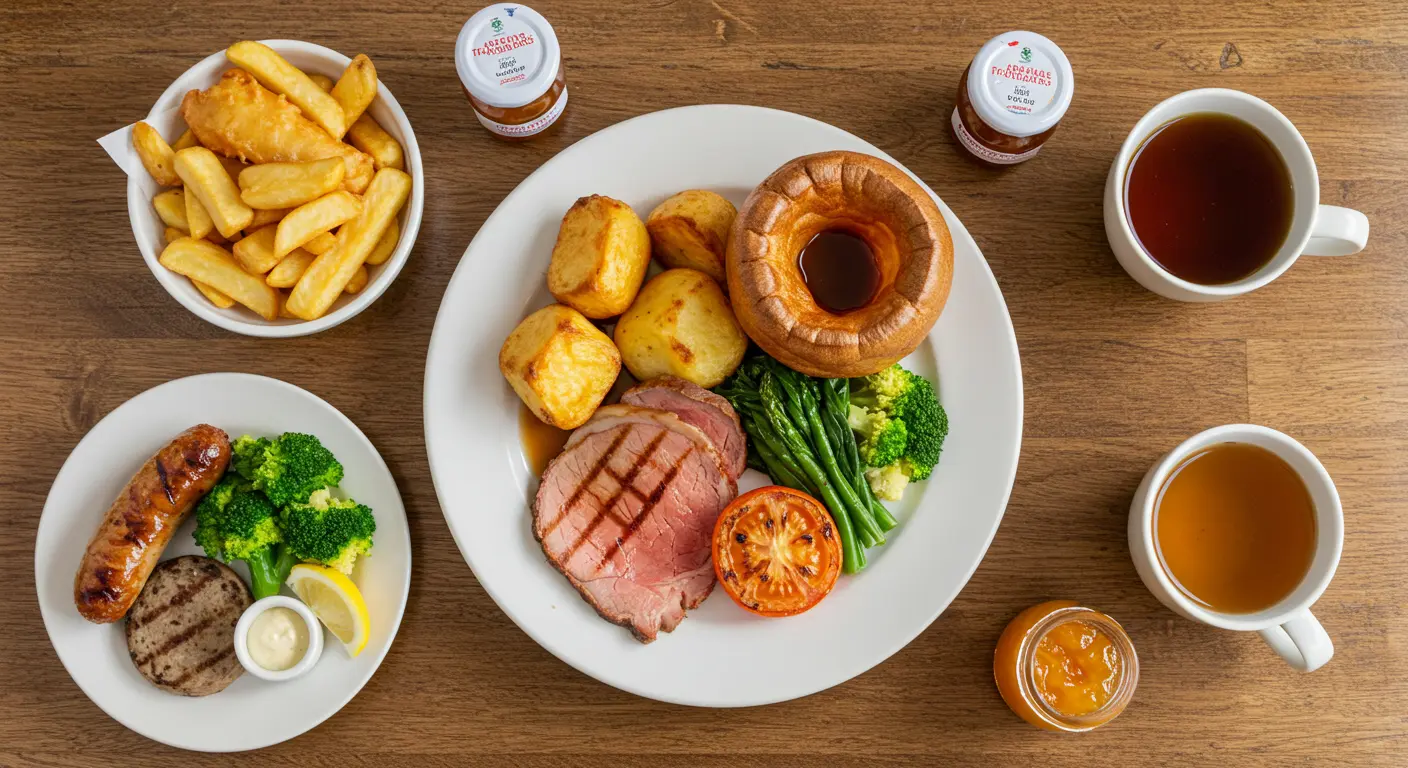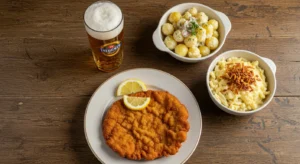Table of Contents
A Beginner’s Guide to United Kingdom Food: Beyond Fish and Chips
So, you think you know United Kingdom food? If your mind immediately jumps to fish and chips eaten from a newspaper or a bland plate of roast beef, you’re not alone. But you’re also missing out on one of the world’s most surprising and comforting culinary landscapes.
For decades, British cuisine was the punchline of a bad joke, often unfairly dismissed as stodgy, flavourless, and overcooked. But here’s the truth: that old stereotype is as outdated as a black-and-white TV. The food scene across England, Scotland, Wales, and Northern Ireland has undergone a breathtaking transformation. Today, it’s a vibrant tapestry of deep-rooted tradition, regional specialties, and bold, modern innovation.
This guide is your friendly starting point. We’re going to pull up a chair and explore the real United Kingdom food—the hearty classics that have comforted generations, the unique dishes you simply have to try, and the exciting new trends putting British cuisine firmly on the global foodie map. Ready? Let’s tuck in.
A Bite of History: How Britain’s Past Shaped Its Plate
To understand the food, you need a little context. British cuisine is a story of invasion, empire, and resilience. It’s surprisingly simple at its core, born from a temperate climate ideal for raising livestock and growing sturdy vegetables.
- The Humble Beginnings: Think rolling green hills and craggy coastlines. This geography gave Britain its foundational ingredients: superb beef and lamb, an abundance of seafood (cod, haddock, oysters), and root vegetables like potatoes, parsnips, and swedes.
- The Spice Routes: While the medieval diet was hearty, it wasn’t exactly spicy. That changed with the British Empire. The quest for tea, sugar, and spices from India and the Caribbean introduced new flavours that would eventually lead to beloved creations like curry (more on that later!).
- Post-War Austerity: This is where the “bad reputation” truly began. The rationing during and after World War II (lasting into the 1950s!) meant a generation grew up with limited access to fresh, flavourful ingredients. Convenience foods became king, and the art of traditional cooking was, for a time, lost.
But from those tough times emerged a renewed appreciation for quality. The modern food revolution, championed by figures like Delia Smith and later, Hugh Fearnley-Whittingstall and Nigella Lawson, rekindled a passion for local, seasonal, and well-cooked food.
The Great British Classics: The Must-Try Dishes
You can’t talk about UK food without celebrating the icons. These are the dishes that form the bedrock of the national diet, especially when it comes to home cooking and the beloved “pub grub.”
The Full English Breakfast
Forget a quick bowl of cereal. The Full English is a legendary affair, a plate designed to fortify you for the entire day. It’s a symphony of components: fried eggs, bacon, sausages, baked beans, grilled tomatoes, mushrooms, and often black pudding (a type of blood sausage). It’s greasy, glorious, and the ultimate weekend treat. In Scotland, it becomes a Full Scottish with the addition of items like Lorne sausage and tattie scones.
The Sunday Roast
This is more than a meal; it’s a weekly ritual, a time for families to gather. At its heart is a large joint of meat—beef, chicken, lamb, or pork—roasted to perfection. It’s served with fluffy Yorkshire puddings (savoury, batter-based puffs, especially with beef), roasted potatoes crispy on the outside and fluffy within, a selection of vegetables, lashings of rich meat gravy, and, for the brave, horseradish or mint sauce.
Fish and Chips
Okay, we have to mention it—because when it’s done right, it’s sublime. This isn’t just fast food; it’s a national treasure. The secret is in the details: fresh, flaky cod or haddock encased in a light, crispy beer batter, served alongside thick-cut chips ( fries, but chunkier and softer). It’s traditionally sprinkled with salt and malt vinegar and, in the North of England, sometimes accompanied by mushy peas. The authentic experience involves eating it straight from the paper, by the seaside.
Shepherd’s Pie & Cottage Pie
The ultimate comfort food. Both are hearty pies with a savoury minced meat base, topped with a creamy layer of mashed potato and baked until golden. The difference? Shepherd’s Pie uses lamb (shepherds tend sheep, after all!), while Cottage Pie uses beef. It’s the kind of simple, satisfying dish that tastes like a hug from the inside.
A Tour of the Nations: Regional Gems You Need to Know
The United Kingdom is a union of four distinct countries, each with its own culinary pride.
Scottish Specialties
Scotland is a land of robust, no-nonsense flavours.
- Haggis, Neeps & Tatties: The national dish often intimidates visitors (it’s made from sheep’s offal, oats, and spices, cooked in a casing). But it’s genuinely delicious—savoury, peppery, and rich. It’s always served with “neeps” (mashed swede/rutabaga) and “tatties” (mashed potatoes). Don’t knock it ‘til you’ve tried it!
- Cullen Skink: A creamy, smoky soup made from finnan haddie (smoked haddock), potatoes, and onions. It’s Scotland’s answer to chowder and will warm you up on the coldest day.
- Aberdeen Angus Beef: Renowned worldwide for its exceptional marbling and flavour.
Welsh Wonders
Welsh cuisine is heavily influenced by its rugged landscape and coast.
- Welsh Cawl: Pronounced “cawl,” this is a traditional lamb and vegetable broth that simmers for hours, developing a deep, comforting flavour.
- Welsh Rarebit: Forget “cheese on toast.” This is a sophisticated version where a rich sauce of melted cheese, ale, mustard, and Worcestershire sauce is poured over toast and grilled. It’s a pub menu staple for a reason.
- Glamorgan Sausage: A vegetarian delight from the past—a “sausage” made from cheese, leeks, and breadcrumbs.
Northern Irish Nourishment
- Ulster Fry: Similar to the Full English but with its own unique twists, often including soda bread and potato bread.
- Irish Stew: A simple, hearty stew traditionally made with lamb, potatoes, onions, and carrots.
- Pasties & Soda Bread: The influence of Ireland is strong here, with delicious, flaky pasties and dense, tasty soda bread.
The Modern British Food Revolution
Now for the really exciting part. Over the last 30 years, UK food has exploded with creativity. “Modern British” cuisine isn’t just a label; it’s a philosophy.
It’s all about taking those fantastic native ingredients—the seafood from Cornwall, the lamb from Wales, the cheese from Somerset—and treating them with respect and imagination. Chefs like the legendary Marco Pierre White kicked things off, but today, you’ll find incredible, innovative food everywhere, from Michelin-starred restaurants in London to unassuming bistros in Edinburgh.
This movement is deeply connected to farm-to-table ethics. There’s a huge emphasis on seasonality, sustainability, and supporting local producers. Visit a farmers’ market in any town on a Saturday, and you’ll see this passion firsthand.
And we can’t talk about modern Britain without mentioning the Chicken Tikka Masala. Often joked about as the UK’s true national dish, this creamy curry wasn’t invented in India but in British curry houses. It’s a perfect symbol of the UK’s multicultural identity—a dish born from the meeting of cultures that the nation has wholeheartedly adopted and made its own.
Ready to Explore? Your Beginner’s Action Plan
Feeling hungry? Here’s how you can start your journey into the United Kingdom food:
- Find a Proper Pub: Skip the chain restaurants. Look for a traditional, independent pub with a menu full of classics. Order a pie, a roast (on a Sunday!), or a ploughman’s lunch.
- Visit a Farmers’ Market: Experience the quality and variety of local produce. Talk to the vendors—they’re a wealth of knowledge.
- Be Adventurous: Try the haggis. Sample the black pudding. Order the sticky toffee pudding for dessert (you can thank me later). The quirkiest dishes are often the most memorable.
- Explore the High Street: Take a walk down any town’s main street and you’ll see the diversity: a classic chippy, a modern gastropub, a South Asian curry house, and a trendy café all within a few feet. That is the United Kingdom food today.
For a fantastic, authoritative resource on seasonal British produce and recipes, check out the Great British Chefs website. It’s a brilliant showcase of the talent and ingredients that make the current food scene so vibrant.
Frequently Asked Questions (FAQs)
Q: Is British food really as bad as its reputation?
A: Not anymore! While the post-war era gave British food a bad name, the last few decades have seen an incredible culinary renaissance. The focus is now on high-quality, seasonal ingredients and creative cooking, making it a fantastic destination for food lovers.
Q: What is a typical breakfast in the UK?
A: On a weekday, it’s likely to be quick—cereal, toast, or porridge. The famous “Full English” or “Fry-up” is a large cooked meal typically reserved for weekends or as a special treat.
Q: What’s the difference between a pub and a restaurant?
A: A traditional pub (public house) is primarily a place to drink beer, but most also serve food in a relaxed, informal setting. A “gastropub” is a pub that elevates its food to restaurant quality. A restaurant is focused solely on the dining experience.
Q: Why is Indian food so popular in the UK?
A: This stems from Britain’s historical connections with the Indian subcontinent. Immigration led to the establishment of curry houses, and dishes like Chicken Tikka Masala were adapted to British tastes, becoming immensely popular and a staple of the national diet.
Q: What should I drink with my meal?
A: In a pub, a pint of real ale or cider is the classic accompaniment. Britain also has fantastic craft breweries. For a non-alcoholic option, a cup of strong British tea is always a good choice!
The Final Course
United Kingdom food is a story of surprise. It’s about discovering that there’s so much more than the stereotypes. It’s the deep comfort of a home-cooked stew, the crispy perfection of properly fried fish, and the thrilling innovation on a plate in a city restaurant.
It’s a cuisine that’s proud of its past but isn’t living in it. So, the next time you get the chance, go beyond the familiar. Order the dish you can’t pronounce. Ask a local for their favourite spot. You might just find that United Kingdom food becomes one of your favourite discoveries.
Now, who’s fancying a cuppa?




